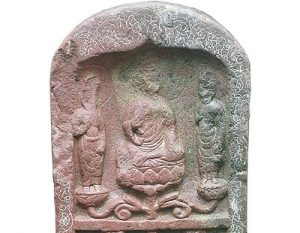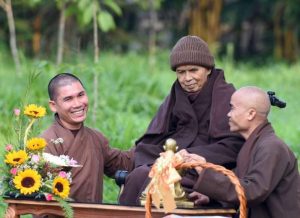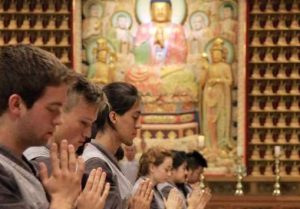
The multiple meanings of the Chinese word “xin”
In the Chinese language, faith and belief are described by the word “xin” (信), which can be translated as faith, belief, trust, confidence, reliability, or even honesty. Although all of these concepts are considered virtuous, the appropriate usage of the word depends on the specific circumstances. Many Chinese Buddhists confuse the meanings of xin, thus they may misunderstand the true meaning of faith in the context of Pure Land Buddhism.
People may say, “I believe in Amitabha Buddha,” “I have faith in Amitabha Buddha,” “I rely on Amitabha Buddha,” “I entrust myself to Amitabha Buddha,” or “I am confident about my rebirth in the Land of Bliss.” Is there any difference between these statements? They use the same word, xin, to express a mental quality in relation to Pure Land teachings. This one word is used to reflect the many shades of meaning in the word “believe,” including depth of belief, and how thoroughly people comprehend the Dharma, accept the Dharma, and practice for rebirth in the Land of Bliss.
Belief through testimony worthy of confidence
Amitabha Buddha is not a historical person like Shakyamuni Buddha—no one has ever encountered him as a physical entity. It is through the testimony of Shakyamuni Buddha that we know of him. In the Amitabha Sutra, the Buddha says: “From here, passing one hundred thousand kotis* of Buddha lands, you come to the Land of Bliss, where there is a Buddha named Amitabha. He is living there now, teaching the Dharma.”
Unfortunately, Amitabha is too far away for us to see him. Due to our heavy karmic obscurations, we cannot see his splendid body, which exists on a much higher plane of reality. In that case, on what do we base our belief in the existence of Amitabha Buddha? The answer is, through the words of a reliable witness. In Buddhism, this is called “belief through testimony worthy of confidence.”
Shakyamuni Buddha is the Supremely Enlightened One, and the wisest, kindest person in the world, so he is eminently trustworthy and reliable. We believe in what he says; we follow what he teaches; we abide by what he wishes us to do. It is this kind of “belief through respect” that Pure Land Buddhism emphasizes.
However, belief through testimony worthy of confidence is the most difficult way for an ordinary being to believe, unless one has deep roots of virtue accumulated through zealous cultivation in past lives. Shakyamuni Buddha says in the Amitabha Sutra that the Pure Land Dharma is the most difficult of teachings to believe in. So, when an ordinary being hears of it for the first time, it is very rare that she believes in and accepts it right away. We will discuss this in a later article.
For non-Buddhists who do not believe in an “afterlife,” it is difficult in the extreme to understand and accept the Pure Land teachings. They may even criticize those who believe the Buddha’s words about Amitabha Buddha and his Land of Bliss as being superstitious, or as having “blind” faith. However, it is often the case that such critics have never before encountered the Buddhist teachings and do not know who or what the Buddha is.
Belief through irrefutable deduction
How do we know that Shakyamuni Buddha is the Supremely Enlightened One, the wisest and kindest, and most trustworthy and reliable person in the world? Shakyamuni “died” or entered nirvana some 2,500 years ago in northern India. Today, we know about the Buddha from the sutras spoken by him, including the three Pure Land sutras.
All of the Buddha’s disciples were great sages, advanced in wisdom and morality. They posed numerous questions to him on all aspects of the nature of existence. In response, the Buddha gave perfect and complete answers to clear away their doubts and those of future generations who would encounter the Buddha-Dharma. While we may not understand everything that is discussed in the sutras, we do know that these great sages were satisfied with the Buddha’s words. They believed in, accepted, followed, and practiced the teachings so that they eventually achieved their spiritual goals.
More importantly, if we apply the Buddhist teachings in our daily lives we receive the benefit of having our doubts removed; our minds become relaxed, and our relationships improve. Gradually, our confidence in the teachings contained within the sutras grows stronger. This process of application, testing, and verification is known as “belief through irrefutable deduction,” and is a methodology emphasized by many schools of Buddhism.
Modern people generally accept this path to understanding and regard it as an analytical or scientific approach. Such a methodology is readily accepted by secular materialist sensibilities. As this process of understanding takes place within one’s mind, “belief through irrefutable deduction” is often considered a rational and intellectual way to understand religious teachings. (Nevertheless, matters of a metaphysical nature, such as those concerning Amitabha Buddha and the Land of Bliss, cannot be directly apprehended in this way.)
However, due to the subtleties of many Buddhist concepts, the limitations of language, and the unequal powers of comprehension among human beings, few can understand and believe in the Buddhist teachings through irrefutable deduction and thus establish faith in Shakyamuni Buddha.
Belief through direct experience
Ordinary beings usually make judgments about a matter based on past experience; if the parameters of a proposition agree with what we already know to be true, we generally accept it. While it is easy for us to attain this kind of “belief through direct experience,” such beliefs are still biased, limited to our individual perspective, and thus often unreliable. Our subjectivity can lead to errors in the processing and interpreting of information. In addition, the objective data available to us through our senses is usually only part of a much larger story.
When it comes to evaluating the Buddha-Dharma, it is highly unlikely for us—in our present lives—to have had personal contact with Shakyamuni Buddha and to have learned his teachings under his direct guidance. In Pure Land Buddhism, we believe in a Buddha called Amitabha, revealed by Shakyamuni Buddha, but it is unlikely that any of us has seen Amitabha with our own eyes or heard his voice with our own ears. Without the roots of virtue, how can ordinary beings believe in the existence of Amitabha Buddha and establish “faith” in Amitabha’s deliverance?
Although three ways of attaining belief are mentioned above, none of them is regarded as constituting “faith”—a profoundly deep and firm belief. Faith is a root of virtue that is established through the practices of diligence, mindfulness, and meditation. Let us discuss this in the next article.
*(Sanskrit) An ancient Indian numerical unit used to indicate an astronomically large number. Often translated as meaning 10 million.











